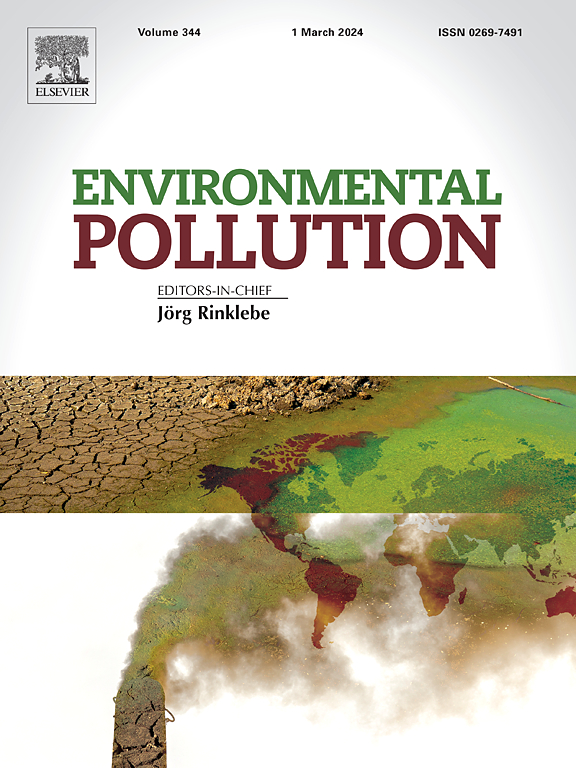Toxicity prediction and risk assessment of per- and polyfluoroalkyl substances for threatened and endangered fishes
IF 7.6
2区 环境科学与生态学
Q1 ENVIRONMENTAL SCIENCES
引用次数: 0
Abstract
Per- and polyfluoroalkyl substances (PFASs) are severely polluted in aquatic environments and can harm aquatic organisms. Due to the limitation of conducting toxicity experiments directly on threatened and endangered (T&E) species, their toxicity data is scarce, hindering accurate risk assessments. The development of computational toxicology makes it possible to assess the risk of pollutants to T&E fishes. This study innovatively combined machine learning models, including random forest (RF), artificial neural network (ANN), and XGBoost, and the QSAR-ICE model to predict chronic developmental toxicity data of PFASs to T&E fishes. Among these, the XGBoost model exhibited superior performance, with R of 0.95 and 0.81 for the training and testing sets, respectively. Internal and external validation further confirmed that the XGBoost model is robust and reliable. Subsequently, it was used to predict chronic developmental toxicity data for seven priority PFASs to T&E fishes in the Yangtze River. Acipenseridae fishes (e.g., and ) showed high sensitivity to PFASs, possibly due to their unique lifestyle and physiological characteristics. Based on these data, the predicted no-effect concentration (PNEC) of individual PFASs was calculated, and the risk for T&E fishes in the Yangtze River was assessed. The results indicated that the risk of PFASs to T&E fishes is low (3.85 × 10∼8.20 × 10), with perfluorohexanoic acid (PFHxA) and perfluorooctanoic acid (PFOA) as the high-risk pollutants. The risk in the middle and lower reaches of the river is higher than in the upper reaches. This study provides a new approach for obtaining chronic toxicity data and conducting risk assessments for T&E species, advancing the protection of T&E species worldwide.全氟和多氟烷基物质对受威胁和濒危鱼类的毒性预测和风险评估
全氟烷基和多氟烷基物质(PFASs)在水生环境中污染严重,会对水生生物造成危害。由于无法直接对受威胁和濒危(T&E)物种进行毒性实验,其毒性数据非常稀少,阻碍了准确的风险评估。计算毒理学的发展使评估污染物对 T&E 鱼类的风险成为可能。本研究创新性地将随机森林(RF)、人工神经网络(ANN)、XGBoost等机器学习模型与QSAR-ICE模型相结合,预测PFASs对T&E鱼类的慢性发育毒性数据。其中,XGBoost 模型表现优异,训练集和测试集的 R 值分别为 0.95 和 0.81。内部和外部验证进一步证实了 XGBoost 模型的稳健性和可靠性。随后,该模型被用于预测七种优先考虑的全氟辛烷磺酸对长江T&E鱼类的慢性发育毒性数据。鲟科鱼类(如和)对 PFASs 表现出高度敏感性,这可能与它们独特的生活方式和生理特征有关。根据这些数据,计算了个别 PFASs 的预测无效应浓度 (PNEC),并评估了其对长江鲢鳙鱼类的风险。结果表明,PFASs 对 T&E 鱼类的风险较低(3.85 × 10∼8.20 × 10),其中全氟己酸(PFHxA)和全氟辛酸(PFOA)为高风险污染物。河流中下游的风险高于上游。这项研究为获取T&E物种的慢性毒性数据和进行风险评估提供了一种新方法,推动了全球对T&E物种的保护。
本文章由计算机程序翻译,如有差异,请以英文原文为准。
求助全文
约1分钟内获得全文
求助全文
来源期刊

Environmental Pollution
环境科学-环境科学
CiteScore
16.00
自引率
6.70%
发文量
2082
审稿时长
2.9 months
期刊介绍:
Environmental Pollution is an international peer-reviewed journal that publishes high-quality research papers and review articles covering all aspects of environmental pollution and its impacts on ecosystems and human health.
Subject areas include, but are not limited to:
• Sources and occurrences of pollutants that are clearly defined and measured in environmental compartments, food and food-related items, and human bodies;
• Interlinks between contaminant exposure and biological, ecological, and human health effects, including those of climate change;
• Contaminants of emerging concerns (including but not limited to antibiotic resistant microorganisms or genes, microplastics/nanoplastics, electronic wastes, light, and noise) and/or their biological, ecological, or human health effects;
• Laboratory and field studies on the remediation/mitigation of environmental pollution via new techniques and with clear links to biological, ecological, or human health effects;
• Modeling of pollution processes, patterns, or trends that is of clear environmental and/or human health interest;
• New techniques that measure and examine environmental occurrences, transport, behavior, and effects of pollutants within the environment or the laboratory, provided that they can be clearly used to address problems within regional or global environmental compartments.
 求助内容:
求助内容: 应助结果提醒方式:
应助结果提醒方式:


